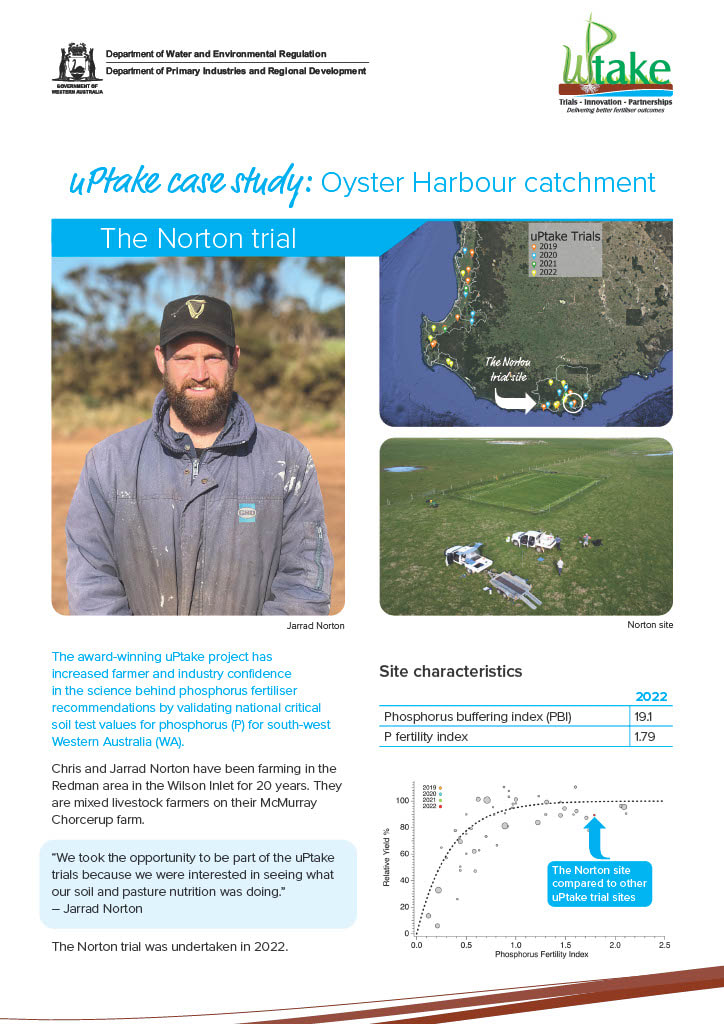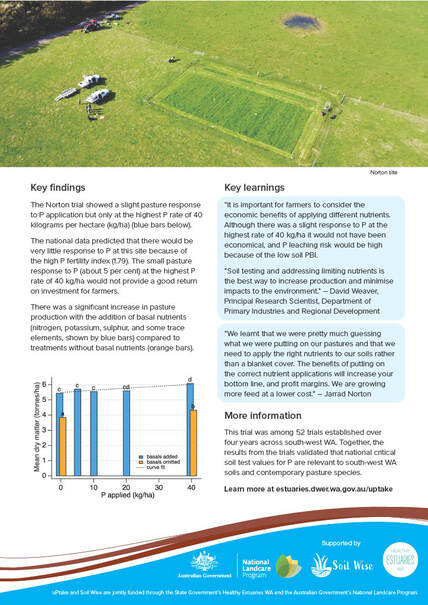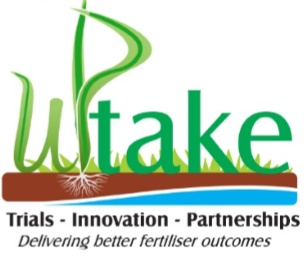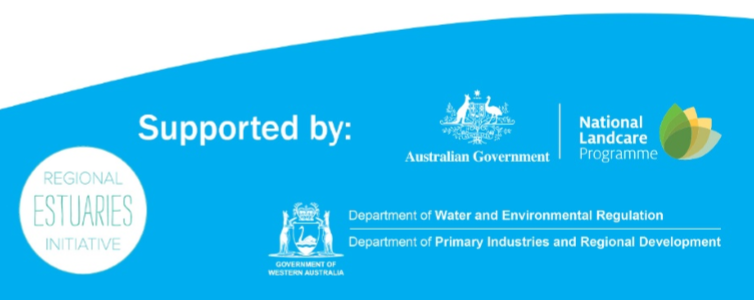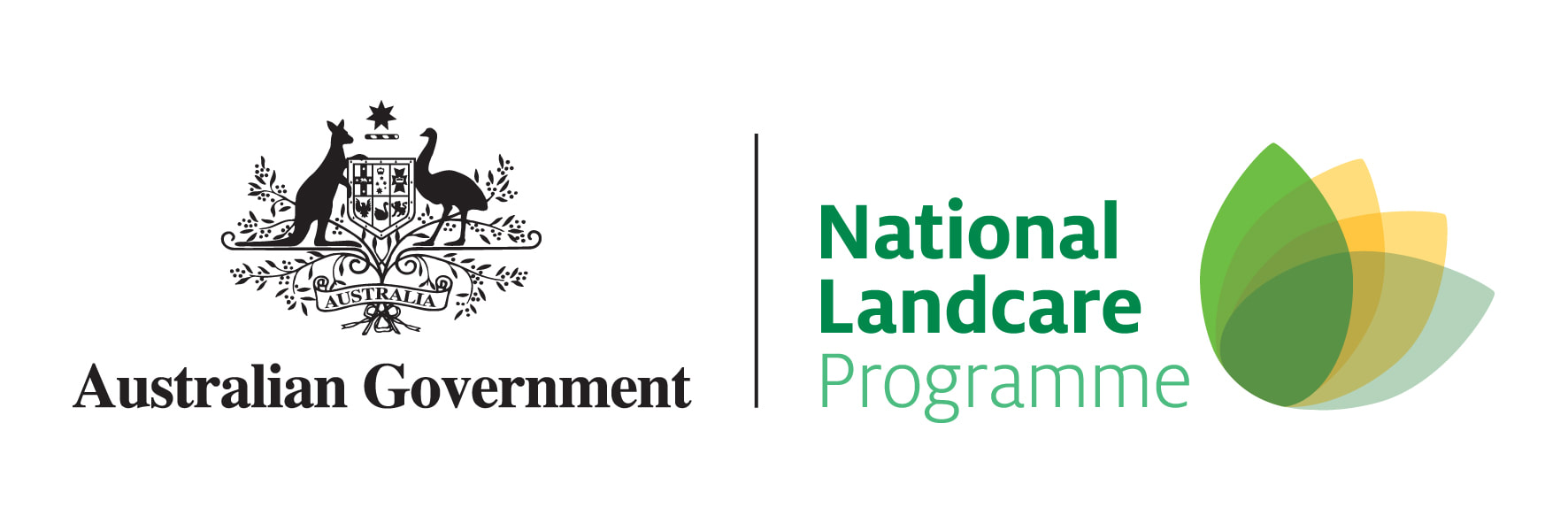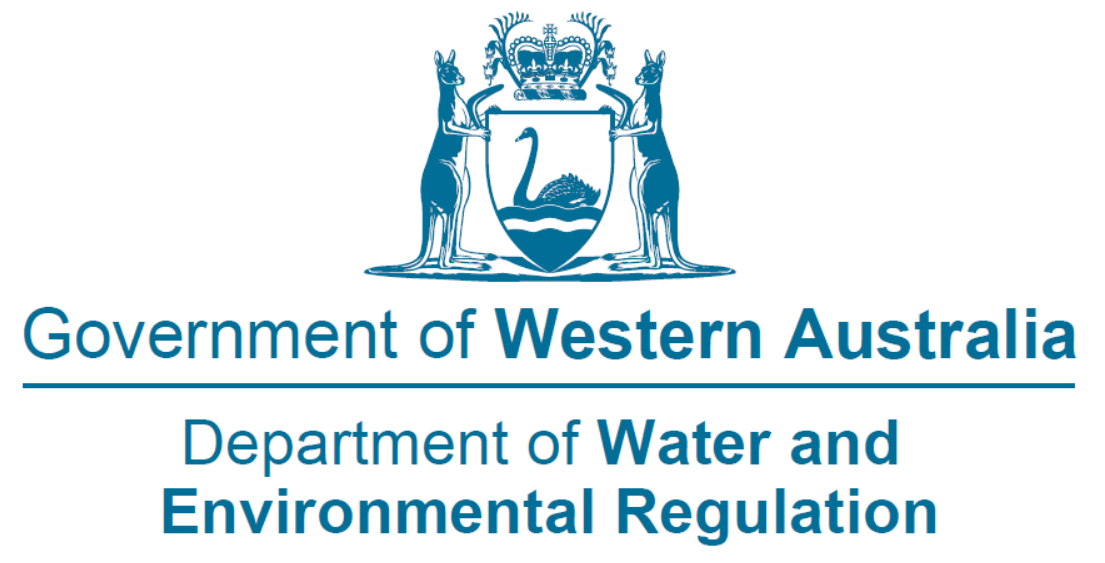"uPtake" originally called "smart farming" is a partnership project designed to improve nutrient use efficiency on grazing farms in South West Western Australia by improving farmer and industry knowledge, confidence and uptake of the science supporting fertiliser recommendations.
This project has established at least 36 fertiliser trials across the South West over a range of soil types with contemporary pasture species to develop phosphorus response curves.
OHCG are hosting four of these on-farm fertilizer trials over the next three years. These trials explore innovative technology and practices to improve nutrient use efficiency on grazing farms in the South West and reduce excess nutrient runoff into waterways and estuaries.
See Norton Family Case study as an example click here
This project has established at least 36 fertiliser trials across the South West over a range of soil types with contemporary pasture species to develop phosphorus response curves.
OHCG are hosting four of these on-farm fertilizer trials over the next three years. These trials explore innovative technology and practices to improve nutrient use efficiency on grazing farms in the South West and reduce excess nutrient runoff into waterways and estuaries.
See Norton Family Case study as an example click here
This project is designed to measure pasture growth across a range of soils with different levels of phosphorous and other nutrients are applied, improving industry and farmer confidence in evidence-based fertiliser management. Representatives from major fertiliser companies, dairy and beef industry groups, scientists, farmers and state government agencies and catchment management bodies collaborate to form a technical advisory group to ensure success of the program.
The first measurements commenced last month. Pasture growth is being measured in a number of ways including some innovative new methods. These include use of drones with infa-red and NVDI imagery, traditional pasture cuts and visual assessment, as well as sonar (similar to echo sounder). Results should give local farmers more confidence in determining the correct phosphorous applications to achieve production targets with minimal waste and leaching into waterways. Thanks to CSBP for their support and involvement in both accuspread and the uPtake program.
Garan Peirce, District Manager from CSBP fertilisers attended the technical group meeting and said “I’m confident the project will build on current industry knowledge of efficient and effective nutrient use for the longer term benefit of farmers and the local environment”.
Cameron Allan, Program Manager from Meat & Livestock Australia said the participants were an excellent mix to address this multi-faceted issue requiring underpinning science, demonstrations, communication and establishing a common value message from advisors and agribusiness.
“The issues being addressed by the project bridges the production needs of both regional beef and dairy producers, resource management, applied research, agribusiness and information delivery,”
The first measurements commenced last month. Pasture growth is being measured in a number of ways including some innovative new methods. These include use of drones with infa-red and NVDI imagery, traditional pasture cuts and visual assessment, as well as sonar (similar to echo sounder). Results should give local farmers more confidence in determining the correct phosphorous applications to achieve production targets with minimal waste and leaching into waterways. Thanks to CSBP for their support and involvement in both accuspread and the uPtake program.
Garan Peirce, District Manager from CSBP fertilisers attended the technical group meeting and said “I’m confident the project will build on current industry knowledge of efficient and effective nutrient use for the longer term benefit of farmers and the local environment”.
Cameron Allan, Program Manager from Meat & Livestock Australia said the participants were an excellent mix to address this multi-faceted issue requiring underpinning science, demonstrations, communication and establishing a common value message from advisors and agribusiness.
“The issues being addressed by the project bridges the production needs of both regional beef and dairy producers, resource management, applied research, agribusiness and information delivery,”
OHCG is hosting four of the thirty six on-farm fertilizer trials over the next three years to discover the fertiliser requirements including phosphorus under local conditions, as part of the Smart Farming Partnership project "uPtake". These trials explore innovative technology and practices to improve nutrient use efficiency on grazing farms in the South West and reduce excess nutrient runoff into waterways and estuaries.
This project is designed to measure pasture growth across a range of soils with different levels of phosphorous and other nutrients are applied, improving industry and farmer confidence in evidence-based fertiliser management. Representatives from major fertiliser companies, dairy and beef industry groups, scientists, farmers and state government agencies and catchment management bodies collaborate to form a technical advisory group to ensure success of the program.
The first measurements commenced last month. Pasture growth is being measured in a number of ways including some innovative new methods. These include use of drones with infa-red and NVDI imagery, traditional pasture cuts and visual assessment, as well as sonar (similar to echo sounder). Results should give local farmers more confidence in determining the correct phosphorous applications to achieve production targets with minimal waste and leaching into waterways. Thanks to CSBP for their support and involvement in both accuspread and the uPtake program.
Garan Peirce, District Manager from CSBP fertilisers attended the technical group meeting and said “I’m confident the project will build on current industry knowledge of efficient and effective nutrient use for the longer term benefit of farmers and the local environment”.
Cameron Allan, Program Manager from Meat & Livestock Australia said the participants were an excellent mix to address this multi-faceted issue requiring underpinning science, demonstrations, communication and establishing a common value message from advisors and agribusiness.
“The issues being addressed by the project bridges the production needs of both regional beef and dairy producers, resource management, applied research, agribusiness and information delivery,”
Contact Bruce Radys our REI project officer to learn more 0428 994 408 or [email protected].
This project is designed to measure pasture growth across a range of soils with different levels of phosphorous and other nutrients are applied, improving industry and farmer confidence in evidence-based fertiliser management. Representatives from major fertiliser companies, dairy and beef industry groups, scientists, farmers and state government agencies and catchment management bodies collaborate to form a technical advisory group to ensure success of the program.
The first measurements commenced last month. Pasture growth is being measured in a number of ways including some innovative new methods. These include use of drones with infa-red and NVDI imagery, traditional pasture cuts and visual assessment, as well as sonar (similar to echo sounder). Results should give local farmers more confidence in determining the correct phosphorous applications to achieve production targets with minimal waste and leaching into waterways. Thanks to CSBP for their support and involvement in both accuspread and the uPtake program.
Garan Peirce, District Manager from CSBP fertilisers attended the technical group meeting and said “I’m confident the project will build on current industry knowledge of efficient and effective nutrient use for the longer term benefit of farmers and the local environment”.
Cameron Allan, Program Manager from Meat & Livestock Australia said the participants were an excellent mix to address this multi-faceted issue requiring underpinning science, demonstrations, communication and establishing a common value message from advisors and agribusiness.
“The issues being addressed by the project bridges the production needs of both regional beef and dairy producers, resource management, applied research, agribusiness and information delivery,”
Contact Bruce Radys our REI project officer to learn more 0428 994 408 or [email protected].
The Department of Primary Industries and Regional Development and the Department of Water and Environmental Regulation has initiated this project called " Using innovative technology and practices to build capacity and confidence in farmers to improve nutrient use efficiency on grazing farms in South West Western Australia" otherwise referred to as uPtake as seen on their website: https://rei.dwer.wa.gov.au/uptake/
* The project is jointly funded through the State Government's Regional Estuaries Initiative and the Australian Governments' National Landcare Program
* The project is jointly funded through the State Government's Regional Estuaries Initiative and the Australian Governments' National Landcare Program
We acknowledge the Minang and Koreng people as the traditional custodians of the land on which we work and live. We pay our respects to the Elders, past, present, and emerging and to the wider Noongar community.
Sponsors and Supporters

